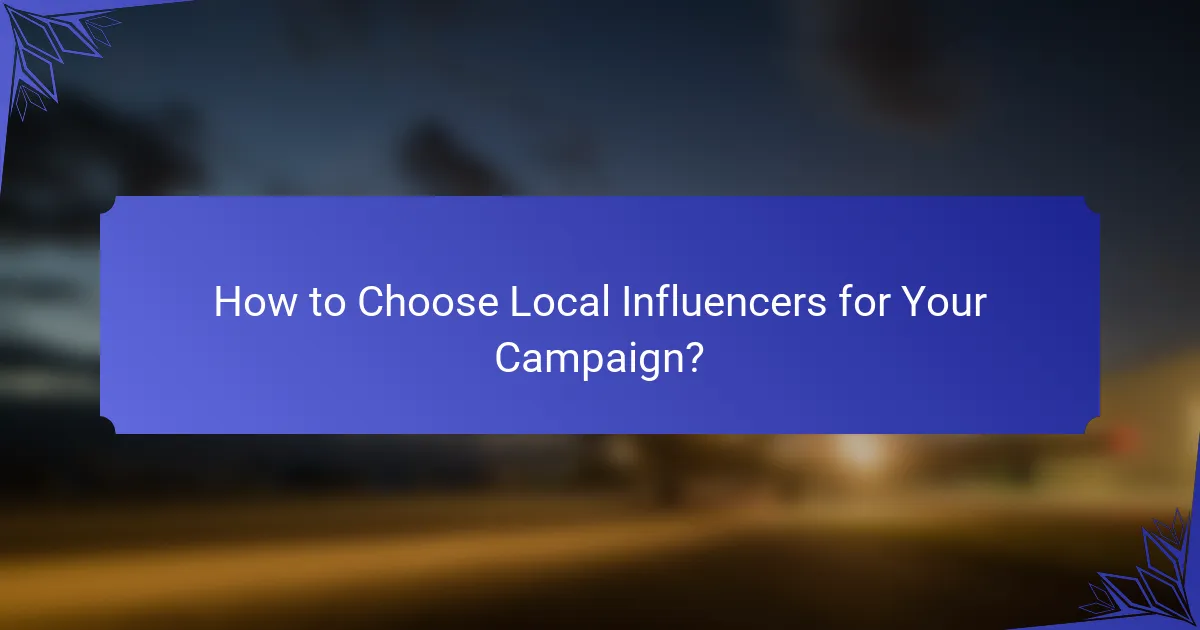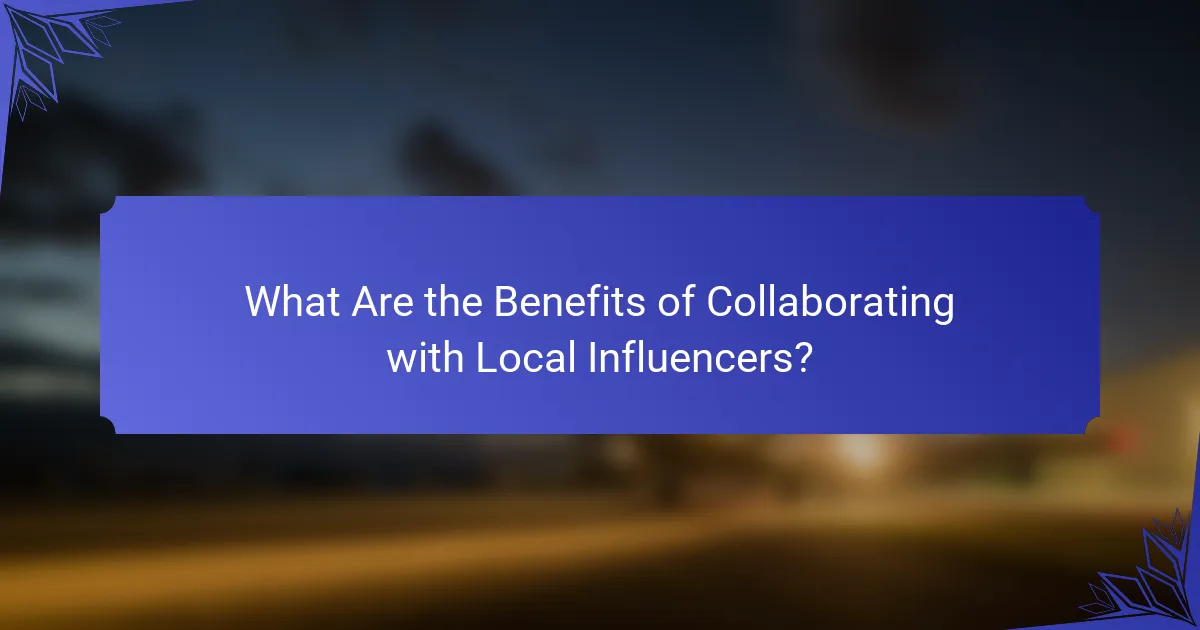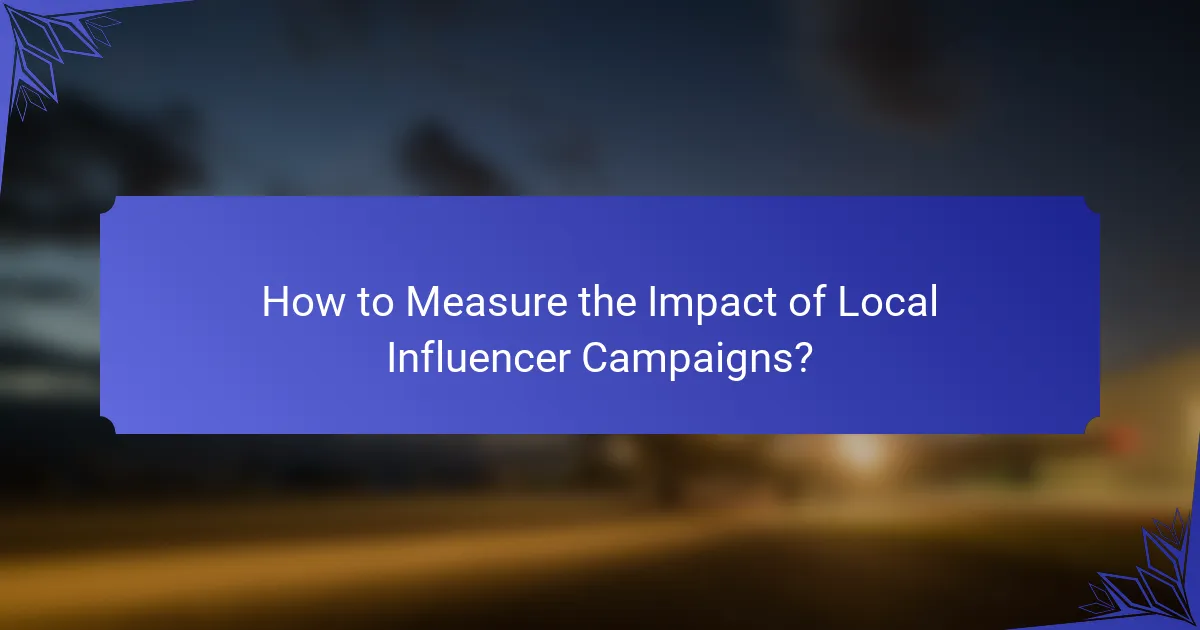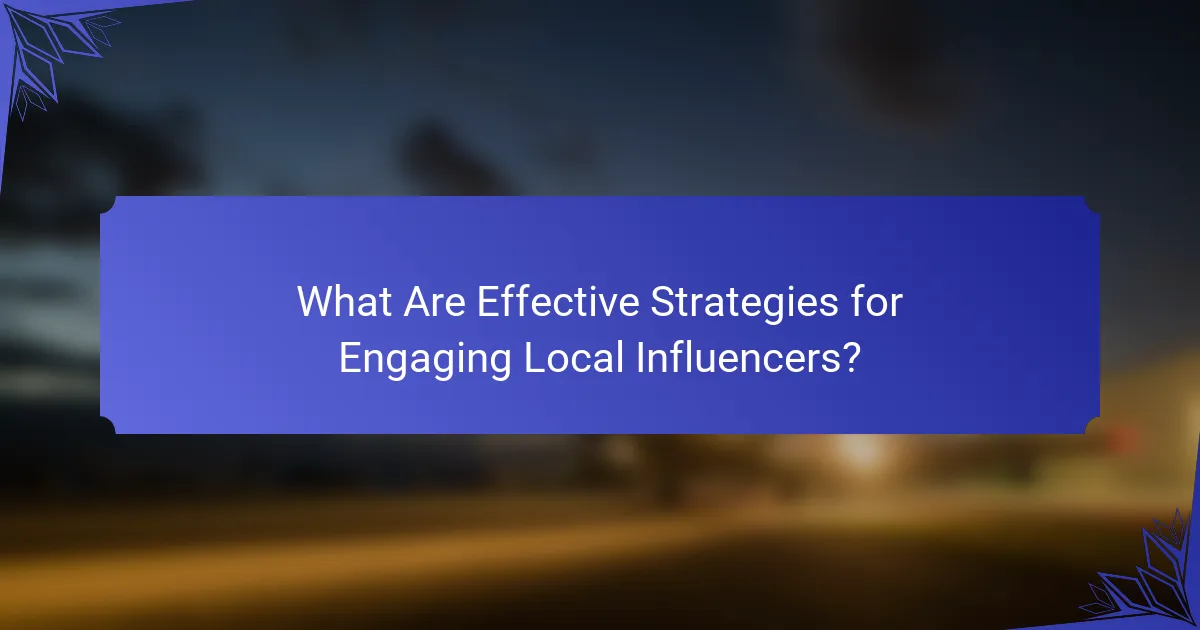Leveraging local influencers can significantly enhance your brand’s visibility and connection within the community. By partnering with individuals who resonate with your target audience and share your brand values, you can build trust, expand your reach, and foster higher engagement rates. Understanding the effectiveness of these collaborations through metrics like engagement and conversion rates is essential for optimizing your marketing strategy.

How to Choose Local Influencers for Your Campaign?
Choosing local influencers involves identifying individuals who resonate with your target audience and align with your brand values. Focus on their relevance, engagement levels, and authenticity to ensure a successful partnership.
Identify niche relevance
Start by determining the specific niche that aligns with your campaign goals. Look for influencers who specialize in areas relevant to your product or service, such as health, fashion, or technology. This ensures that their content naturally integrates with your brand message.
For example, if you are promoting a local organic food product, collaborating with influencers who focus on healthy eating or sustainable living will yield better results than a general lifestyle influencer.
Evaluate engagement metrics
Engagement metrics are crucial indicators of an influencer’s effectiveness. Look for likes, comments, shares, and overall interaction rates on their posts. A high engagement rate, typically above 2-3%, suggests that their audience is actively interested in their content.
Tools like social media analytics platforms can help you assess these metrics. Prioritize influencers who not only have a large following but also foster genuine interactions with their audience.
Assess audience demographics
Understanding the demographics of an influencer’s audience is essential for targeting the right consumers. Analyze factors such as age, gender, location, and interests to ensure alignment with your target market.
For instance, if your product is aimed at young professionals in urban areas, choose influencers whose followers reflect this demographic. This increases the likelihood of resonating with potential customers.
Check authenticity and credibility
Authenticity and credibility are vital for building trust with your audience. Research the influencer’s background, previous partnerships, and the authenticity of their follower count. Avoid influencers with a high percentage of fake followers or those who frequently promote unrelated products.
Engage with their content to gauge their genuine connection with their audience. Authentic influencers often share personal experiences and insights, making their endorsements more relatable.
Consider local presence
A strong local presence can significantly enhance the effectiveness of your campaign. Look for influencers who are well-known in your specific geographic area and have established connections within the community.
Local influencers often have a deeper understanding of regional trends and consumer behavior, making their recommendations more impactful. For example, an influencer based in Sofia promoting a local restaurant will likely have a more engaged audience than a national influencer.

What Are the Benefits of Collaborating with Local Influencers?
Collaborating with local influencers offers brands significant advantages, including increased trust, enhanced reach within the community, and higher engagement rates. These benefits stem from influencers’ established relationships with their audiences, making them effective partners for promoting products or services.
Increased trust and credibility
Local influencers often have a strong rapport with their followers, which translates into higher levels of trust. When they endorse a product, their audience is more likely to view it as a genuine recommendation rather than a paid advertisement.
To leverage this trust, brands should choose influencers whose values align with their own. Authenticity is key; an influencer who genuinely believes in a product will convey that sincerity to their audience, enhancing the brand’s credibility.
Enhanced local reach
Partnering with local influencers allows brands to tap into specific geographic markets effectively. Influencers often have a dedicated local following, which means their promotional efforts can reach potential customers who are nearby and more likely to convert.
Brands should consider the demographics of an influencer’s audience to ensure alignment with their target market. Engaging with influencers who cater to the local community can help businesses gain visibility and foster relationships with local consumers.
Higher engagement rates
Content shared by local influencers typically sees higher engagement rates compared to traditional advertising. Followers are more inclined to interact with posts that feature relatable, local figures, leading to increased likes, comments, and shares.
To maximize engagement, brands should collaborate with influencers to create compelling content that resonates with their audience. This could include behind-the-scenes looks, product demonstrations, or local events, all tailored to the influencer’s style and audience preferences.

How to Measure the Impact of Local Influencer Campaigns?
Measuring the impact of local influencer campaigns involves evaluating engagement, conversion rates, and brand sentiment. These metrics provide insights into how effectively the campaign resonates with the target audience and drives desired actions.
Track engagement metrics
Engagement metrics are critical for assessing how well your local influencer campaigns connect with the audience. Key indicators include likes, shares, comments, and overall reach across social media platforms. Aim for a mix of high engagement rates, typically between 1% to 5%, depending on the platform and audience size.
Utilize tools like Google Analytics, Hootsuite, or native social media insights to gather data. Regularly review these metrics to identify trends and adjust your strategy accordingly. For example, if a particular influencer’s posts generate significantly more comments, consider collaborating with them again.
Analyze conversion rates
Conversion rates indicate how many users take a desired action after engaging with influencer content. This could include signing up for a newsletter, making a purchase, or downloading an app. A good conversion rate for influencer campaigns typically ranges from 1% to 3%, but this can vary based on the industry and campaign goals.
To analyze conversion rates effectively, set up tracking links or unique discount codes for each influencer. This allows you to directly attribute conversions to specific campaigns. Regularly assess these rates to determine which influencers drive the most value for your brand.
Monitor brand sentiment
Brand sentiment reflects how consumers perceive your brand following influencer campaigns. Positive sentiment can lead to increased loyalty and advocacy, while negative sentiment can harm your reputation. Use sentiment analysis tools to gauge audience reactions through comments, reviews, and social media mentions.
Consider conducting surveys or polls to gather direct feedback from your audience about their feelings toward your brand post-campaign. Monitoring sentiment over time can help you identify shifts and adjust your marketing strategies to better align with consumer expectations.

What Are Effective Strategies for Engaging Local Influencers?
Engaging local influencers effectively involves building genuine relationships and creating mutually beneficial opportunities. Focus on collaboration, leveraging social media, and organizing local events to maximize reach and engagement.
Offer value through collaborations
Collaborating with local influencers should be centered around providing value to both parties. Consider co-creating content, such as blog posts or videos, that showcases the influencer’s expertise while promoting your brand. This not only enhances credibility but also attracts their audience to your offerings.
When proposing collaborations, ensure that the benefits are clear. For instance, offering exclusive discounts or products to the influencer’s followers can incentivize participation and foster loyalty. Always aim for a win-win scenario to maintain a positive relationship.
Utilize social media platforms
Social media is a powerful tool for engaging local influencers. Platforms like Instagram, Facebook, and TikTok allow for direct interaction and content sharing. Use these channels to showcase your brand and highlight influencer partnerships, making it easy for their followers to engage with your business.
Consider running targeted ads on these platforms to reach the influencer’s audience effectively. Tailor your messaging to resonate with local interests and trends, ensuring that your content feels relevant and authentic to the community.
Host local events or campaigns
Hosting local events or campaigns is an excellent way to engage influencers and their followers in person. Organize workshops, product launches, or community service initiatives that align with your brand values and invite local influencers to participate or co-host.
Promote these events through social media and local channels to maximize attendance. Offering incentives, such as free products or exclusive experiences, can encourage influencers to share the event with their audience, further expanding your reach and engagement within the local community.

What Tools Can Help Manage Influencer Relationships?
Managing influencer relationships effectively requires the right tools to streamline communication, track performance, and analyze audience engagement. Utilizing specialized platforms can enhance your ability to connect with influencers and measure the impact of your campaigns.
Influencity for analytics
Influencity offers robust analytics tools that help brands evaluate influencer performance and campaign effectiveness. By analyzing metrics such as engagement rates, reach, and audience demographics, you can make informed decisions about which influencers align best with your brand goals.
Consider setting up regular reports to monitor key performance indicators (KPIs) over time. This can help identify trends and optimize future collaborations based on past successes.
BuzzSumo for content discovery
BuzzSumo is a powerful tool for discovering trending content and identifying key influencers in your niche. By searching for specific topics or keywords, you can find popular articles and the influencers who shared them, allowing you to connect with those who have a proven track record of engagement.
Utilize BuzzSumo’s filtering options to narrow down results by date, content type, or social media platform. This targeted approach helps ensure that you are reaching out to influencers who are relevant to your current marketing campaigns.
HypeAuditor for audience analysis
HypeAuditor specializes in audience analysis, providing insights into the authenticity and demographics of an influencer’s followers. This tool helps brands avoid influencers with inflated follower counts and ensures that their marketing efforts reach genuine audiences.
When selecting influencers, look for those with a high engagement rate and a follower base that matches your target market. HypeAuditor’s detailed reports can guide you in making data-driven choices that enhance your campaign’s effectiveness.

What Are Common Mistakes to Avoid with Local Influencers?
Common mistakes with local influencers can undermine your marketing efforts. Failing to consider factors like audience alignment, authenticity, and engagement can lead to ineffective campaigns.
Neglecting audience alignment
Audience alignment is crucial when partnering with local influencers. If the influencer’s followers do not match your target demographic, your message may not resonate, resulting in low engagement and poor return on investment.
To ensure alignment, analyze the influencer’s audience demographics, interests, and engagement rates. Tools like social media analytics can provide insights into follower age, location, and preferences, helping you make informed decisions.
Avoid influencers with a broad audience that doesn’t connect with your niche. Instead, focus on those with a dedicated following that shares interests relevant to your brand, which can enhance trust and effectiveness in your campaigns.


